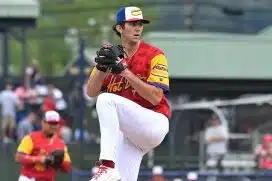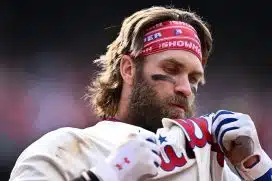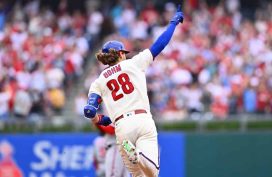By Jason Ferrie and Tim Kelly
, Sports Talk Philly Staff
When the Philadelphia Phillies signed free-agent reliever Tommy Hunter to a two-year/$18 million contract at the MLB Winter Meetings, the signing was panned by some around the league. With all due respect to the talent evaluators that were skeptical of the deal that general manager Matt Klentak issued to Hunter, he was an entirely different pitcher in 2017 than he had previously been. If the Phillies get the version of Hunter that had a career-year in 2017 with the Tampa Bay Rays, they've added another piece to a potentially elite bullpen.
Maybe the word dominant is a bit much, but in 2017, Hunter’s cutter was one of the best in baseball. Per FanGraphs pitch value metric, Hunter possessed the seventh-best cutter among relievers last season. The cutter also turned into Hunter’s most commonly thrown pitch in 2017 – jumping from 20.9-percent in 2016 to 32.6-percent in 2017. A change in how he attacked hitters helped lead him to his most valuable season as a full-time reliever.
Hunter's change in pitch selection led to a decline in sinkers and four-seam fastballs. Hunter threw a four-seam fastball 29.23-percent of pitches in 2016, which dropped to 13.3-percent in 2017. While the sinker drop-off wasn’t as significant, it did drop from 33.6-percent in 2016 to 28.2-percent last season. With the downtick in those pitches, the gain had to go elsewhere – and that was curveballs and cutters. The new distribution of pitches helped Hunter establish a career-best 28.1-percent strikeout rate. Missing bats was a crucial part of Hunter's career-year in 2017, as he posted a career-best 11.5-percent swinging strike rate.
The best part for Hunter is that being a three-to-four pitch reliever makes him unpredictable. Yes, he does feature three variations of a fastball. The problem for hitters is that they’re moving in all different directions at different speeds.
Speaking of different speeds, the 31-year-old also found a different gear velocity-wise in 2017:
|
Pitch |
2016 Velocity |
2017 Velocity |
|
Four-seam |
95.87 |
97.11 |
|
Sinker |
95.39 |
96.61 |
|
Cutter |
91.92 |
94.37 |
Hunter averaged a 97 mph fastball and picked up an additional 2.5 mph on his cutter. He even topped 99 mph on multiple occasions.
Another attractive part about Hunter is his ability to face both left and right-handed hitters. In today's game, it is quite common to see specialty relievers, who will face a lone hitter and then depart. Hunter offers the ability to go a full inning due to his repertoire of pitches, which has led to success against both sides.
In 2017, Hunter featured his cutter primarily against left-handed hitters – utilizing the pitch 52.4-percent of the time. For reference, he featured this pitch against left-handed hitters just 28.4-percent the prior year – meaning he had a major change in his plan of attack. Prior to the 2017 season, it made sense to revisit his plan of attack against left-handed hitters, as they hit .077 with no extra-base hits against the pitch in 2016. While he didn’t replicate the same success against left handers in 2017, he still held them to a respectable .167 average and .238 slugging percentage against the cutter.
While Hunter didn't feature the cutter as often against right-handed hitters in 2017 – he used it just 18.9-percent of the time, he still held righties to a .130 batting average to couple with a .174 slugging percentage. The feature pitch against right-handed hitters for Hunter is his curveball – which he threw 33.6-percent of the time. Hitters managed to hit just .195 against the curve in 2017, so it shouldn’t be a surprise if Hunter primarily features a sinker and curveball combination against right-handed hitters in 2018, while mixing in cutters.
Both because the team has a young pitching staff and an analytically-focused coaching staff, the Phillies are likely their bullpen for more innings in 2018 than they ever have. Hunter – given his increase in the usage of his cutter and an uptick in fastball velocity – figures to be a valuable weapon in whatever role Kapler chooses to utilize him in.
Crazy Happenings in Right Field
Regardless of whether Nick Williams or Aaron Altherr starts in right field on Opening Day, it will be the ninth different Opening Day starter for the Phillies in right field in nine years. Jayson Werth started in 2010; Ben Francisco in 2011; Hunter Pence in 2012; John Mayberry Jr. in 2013; Marlon Byrd in 2014; Grady Sizemore in 2015; Peter Bourjos in 2016 and Michael Saunders in 2017.
Sure, whichever of Williams or Altherr starts in 2017 could also start in 2019, breaking the cycle. Or maybe Williams starts this year and Altherr in 2019. Maybe Roman Quinn or Dylan Cozens has a breakout year in 2018 and starts in 2019. Or maybe the Phillies will sign Bryce Harper this offseason.
- Aaron Nola will be the youngest Opening Day starting pitcher for the Phillies since Dennis Bennett did so (also at the age of 24) in 1964. As the Athletic's Ben Harris noted, he will be the seventh-youngest Opening Day starting pitcher in franchise history.
- Speaking of Nola starting on Opening Day, some have suggested that if the Phillies were to sign Jake Arrieta, perhaps the 2015 National League Cy Young Award winner would get the nod on Opening Day. First of all, it's hard to envision any player signed this late being the Opening Day starter over Nola, who had a breakout 2017 campaign. Secondly, while Arrieta has started on Opening Day once, Nola was the better pitcher in 2017 and is deserving of the Opening Day nod regardless. In nearly identical workloads in 2017 – Arrieta pitched 168.1 innings in 2017, while Nola pitched 168.0 – Nola had a FIP that was 0.89 lower than Arrieta's, and posted a 4.3 fWAR, as compared to a 2.4 fWAR from Arrieta.
- MLB.com's Daren Willman tweeted out some cool baseball history maps over the weekend. Of those born in California, Chase Utley, rather amazingly, hasn't been hit by the most pitches. Instead, Gabe Kapler's former teammate Jason Kendall is the all-time leader of those born in California in being hit by pitches. The two states to the north of California, however, are led by former teammates of Utley. Aaron Rowand has been hit more times than any Oregon-born player in MLB history, while Geoff Jenkins is Washington's leader.
- The Phillies have made some minor tweaks to their batting helmets for 2018. Take a look here.
- Here's an interesting statistic: Odubel Herrera hit .702 in 84 at-bats where he lined the ball in 2017. You know who else had a .702 batting average on liners in 2017? Mike Trout.
- New Phillie Carlos Santana said this (roughly translated from Spanish) of Franklyn Kilome in an Instagram post: "If you want to really support a talented baseball player, you have to start following my brother Franklyn Kilome, who is a future star in the Phillies organization." Baseball America says that Kilome, who finished the 2017 season at Double-A Reading, is the Phillies 10th best prospect.
- Speaking of Santana, with a progressive coaching staff, there's a good chance that he's the leadoff hitter for the Phillies at some point during the 2018 season. In 569 career plate appearances hitting first in the lineup, Santana has slashed .252/.371/.470 with 23 home runs, 69 RBIs and 91 walks.







